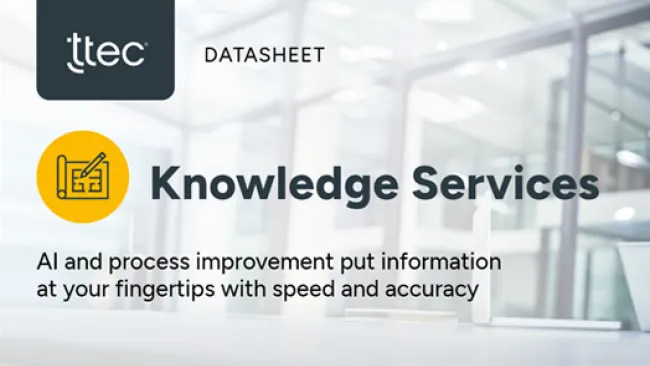There’s an old saying that says sometimes you have to look back to move forward. In the contact center space, interaction analytics, also known as speech analytics, provide organizations with 20/20 vision on their customer interactions and a path for action to enhance them. As contact centers become increasingly digital and add new voice-based channels, more organizations are looking to speech analytics for insights.
But as speech analytics adoption continues to grow, organizations may rush to implement the technology while overlooking key benefits. It’s important that leaders understand where speech analytics can best be utilized to understand associate and customer conversations at different moments of the journey.
Based on my experience and TTEC’s growing capabilities around this technology, here are four key areas where speech analytics can help an organization foster growth, enhance the customer’s journey, and train associates faster and more effectively.
1. Enhanced training
Speech analytics is a fantastic method for discovering information that can be leveraged to train associates productively. Speech analytics identifies not only the keywords, phrases, and emerging topics that are driving successful engagements, but also the cadence in which they should be said or written during the engagement.
Deep diving into past dialogue can help identify what top-performing associates do when interacting with customers and provide insights for other associates, as well as improve the actions of bottom performers. But the main goal isn’t about singling out those who are struggling. Rather, speech analytics can be used to identify coaching opportunities to develop employee skill sets.
How to get it done: Word cloud coaching creates a word cloud of an associate’s language capturing the flow of their conversations. It utilizes replies and reactions in an associate’s dialogue to create coachable insights. Leaders can use word clouds to show associates which aspects of their daily activities need improvement and then guide them on how an ideal conversation should flow. Illustrating a conversation provides a tangible and interactive learning opportunity, as opposed to simply listening to prior calls. As a result, we’ve seen an increase in moving from nesting to full productivity by about 20 percent. In addition, associate attrition was reduced; associates know what is expected of them, and they have a path to achieve their goals.
2. Personalized customer support
If contact centers are to adapt to changing customer expectations, the customer journey must be understood and enhanced. Our experience has shown that there isn’t just one clear path to solving a problem. Every customer enters into the engagement with a unique set of thoughts and expectations. Mapping the customer journey and aligning engagement strategies to meet individual paths drive desired results. Speech analytics provide insight to ensure the right strategies are leveraged through metrics and performance for groups and sometimes to the individual level.
How to get it done: Identify insights into points of the customer journey and develop processes and tactics to deliver the right message to the right person at the right time. Additionally, identify call drivers to enable customer self-service, improve associate training, and enhance call routing.
3. Deeper voice of the customer insights
Speech analytics can be invaluable in uncovering the voice of the customer. Customer sentiment, thoughts about your company and your competitors, emerging topics of relevance and importance, and insights into what your customers care about the most can all be found through interaction or speech analytics.
How to get it done: Share insights from the voice of the customer in the contact center throughout your organization, driving product enhancements, market share gains, increased customer lifetime value, and higher customer satisfaction scores.
4. Enhanced quality assurance and compliance
Quality assurance has traditionally focused on a sample set of calls that are listened to, measured on a scorecard of simple metrics, and applied in coaching that changes results in small steps. But in this environment, a quality assurance team can only listen to so many calls, and their feedback from random calls will not paint an honest picture of what is going on with the majority of associates.
Using speech analytics, you can now “listen” to all interactions, calls, chats, SMS texts, and gain insights into what is really working. Speech analytics can align your quality assurance teams to talking points that impact outcomes and drive the achievement of goals. Furthermore, the added rigor and insights into compliance achievement mitigate the risk a non-compliant interaction can have on a customer relationship.
How to get it done: A more comprehensive approach to quality assurance across the entire engagement cycle provides insights at every point of the interaction between the customer and associate. The findings can help understand the bigger picture of their relationship and a better grasp of the different points of engagement between them.
Unlock your full analytics potential
The true value in interaction and speech analytics comes from applying the processes, uncovering the data, and developing the insights within an operational program that delivers results and feeds the business intelligence machine.
These insights impact many operational areas through business intelligence, particularly in training and curriculum development, coaching, performance, and management. Holistic views and correlation analysis allow us to take seemingly disparate data variables and see the story of cause-and-effect unfold.
For example, a correlation of top reps with more negative sentiment calls and long average handle time (AHT) are analyzed against revenue results. The outcomes tell us that traditional metrics take on a new meaning and value when going outside of traditional scores to discover more pain points. New issues are identified and fixed, resulting in longer associate engagement and higher revenue.
Actions, insights, results
In a contact center, thousands of voices speak at once, but so few are heard. As the renowned author Stephen Covey once said, “Most people do not listen with the intent to understand; they listen with the intent to reply.” It is time to listen to what our associates and customers have to say using interaction and speech analytics, then apply them to help each interaction grow and mature.

















